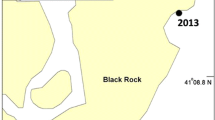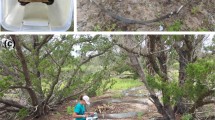Abstract
Native fauna in species poor communities, such as those of the Baltic Sea, may be particularly vulnerable to the effects of species invasions. However, the interspecific interactions that result in the negative impacts on native species tend to be poorly understood. One contributing factor to this knowledge gap may be that the vulnerability of native species can vary between different life-history stages. For example, the parental care phase is often risky both for the developing offspring and care-giving parents. Accordingly, we investigated the interactions between invasive mud crabs, Rhithropanopeus harrissii, and native nest-building littoral fish, with a special focus on the sand goby, Pomatoschistus minutus. Firstly, our field survey demonstrated that while the recently established mud crab and native nest-building fish have different habitat and depth optima, their distributions also have a considerable overlap, with a high potential for interactions between them. Secondly, our laboratory experiments indicate that the crabs are likely to impact the fish negatively, especially by taking over occupied nests, as well as pre-occupying nesting resources that are of very limited supply in the studied population. We did not find evidence for successful predation on eggs guarded by male sand gobies naive to the mud crabs. Collectively, the results suggest that the invasive crabs have high potential to negatively impact native fish. Furthermore, the results support the scenario that the parental phase can be a particularly vulnerable life-history stage in face of novel selection pressures, such as species invasions.





Similar content being viewed by others
References
Aarnio K, Törnroos A, Björklund C, Bonsdorff E (2015) Food web positioning of a recent coloniser: the North American Harris mud crab Rhithropanopeus harrisii (Gould, 1841) in the northern Baltic Sea. Aquat Invasions 10:399–413. https://doi.org/10.3391/ai.2015.10.4.04
Bonsdorff E (2006) Zoobenthic diversity-gradients in the Baltic Sea: continuous post-glacial succession in a stressed ecosystem. J Exp Mar Biol Ecol 330:383–391. https://doi.org/10.1016/j.jembe.2005.12.041
Chin-Baarstad A, Klug H, Lindström K (2009) Should you eat your offspring before someone else does? Effect of an egg predator on filial cannibalism in the sand goby. Anim Behav 78:203–208. https://doi.org/10.1016/j.anbehav.2009.04.022
Clavero M, García-Berthou E (2005) Invasive species are a leading cause of animal extinctions. Trends Ecol Evol 20:110. https://doi.org/10.1016/j.tree.2005.01.003
Cox JG, Lima SL (2006) Naiveté and an aquatic–terrestrial dichotomy in the effects of introduced predators. Trends Ecol Evol 21:674–680. https://doi.org/10.1016/j.tree.2006.07.011
Crawley MJ (2007) The R book. Wiley, Chichester
Ficetola GF, Siesa ME, Manenti R, Bottoni L, De Bernardi F, Padoa-Schioppa E (2011) Early assessment of the impact of alien species: differential consequences of an invasive crayfish on adult and larval amphibians. Divers Distrib 17:1141–1151. https://doi.org/10.1111/j.1472-4642.2011.00797.x
Ficetola GF, Siesa ME, De Bernardi F, Padoa-Schioppa E (2012) Complex impact of an invasive crayfish on freshwater food webs. Biodivers Conserv 21:2641–2651. https://doi.org/10.1007/s10531-012-0323-1
Fonds M (1973) Sand gobies in the Dutch Wadden Sea (Pomatoschistus, Gobiidae, Pisces). Neth J Sea Res 6:417–478
Fonds M, Van Buurt G (1974) The influence of temperature and salinity on development and survival of goby eggs (Pisces, Gobiidae). Hydrobiol Bull 8:110–116. https://doi.org/10.1007/BF02254911
Forsgren E, Kvarnemo C, Lindström K (1996) Mode of sexual selection determined by resource abundance in two sand goby populations. Evolution 50:646–654
Forsström T, Fowler AE, Manninen I, Vesakoski O (2015) An introduced species meets the local fauna: predatory behavior of the crab Rhithropanopeus harrisii in the Northern Baltic Sea. Biol Invasions 17:2729–2741. https://doi.org/10.1007/s10530-015-0909-0
Fowler AE, Forsström T, von Numers M, Vesakoski O (2013) The North American mud crab Rhithropanopeus harrisii (Gould, 1841) in newly colonized Northern Baltic Sea: distribution and ecology. Aquat Invasions 8:89–96. https://doi.org/10.3391/ai.2013.8.1.10
Freeman AS, Byers JE (2006) Divergent induced responses to an invasive predator in marine mussel populations. Science 313:831–833. https://doi.org/10.1126/science.1125485
Gagnon K, Boström C (2016) Habitat expansion of the Harris mud crab Rhithropanopeus harrisii (Gould, 1841) in the northern Baltic Sea: potential consequences for the eelgrass food web. Bioinvasions Rec 5:101–106. https://doi.org/10.3391/bir.2016.5.2.07
Jansson B-O, Aneer G, Nellbring S (1985) Spatial and temporal distribution of the demersal fish fauna in a Baltic archipelago as estimated by SCUBA census. Mar Ecol Prog Ser 23:31–43
Japoshvili B, Lehtonen TK, Wong BBM, Lindström K (2012) Repeatability of nest size choice and nest building in sand gobies. Anim Behav 84:913–917. https://doi.org/10.1016/j.anbehav.2012.07.015
Järvi-Laturi M, Lehtonen TK, Pampoulie C, Lindström K (2008) Parental care behaviour of sand gobies is determined by habitat related nest structure. Behaviour 145:39–50. https://doi.org/10.1163/156853908782687197
Järvi-Laturi M, Lindström K, Kvarnemo C, Svensson O (2011) Sand goby males trade off between defence against egg predators and sneak intrusions. J Zool 283:269–275. https://doi.org/10.1111/j.1469-7998.2011.00788.x
Jones CG, Lawton JH, Shachak M (1994) Organisms as ecosystem engineers. Oikos 69:373–386. https://doi.org/10.1007/978-1-4612-4018-1_14
Jormalainen V, Gagnon K, Sjöroos J, Rothäusler E (2016) The invasive mud crab enforces a major shift in a rocky littoral invertebrate community of the Baltic Sea. Biol Invasions 18:1409–1419. https://doi.org/10.1007/s10530-016-1090-9
Lagakos SW (1979) General right censoring and its impact on the analysis of survival data. Biometrics 35:139–156
Lappalainen A, Urho L (2006) Young-of-the-year fish species composition in small coastal bays in the northern Baltic Sea, surveyed with beach seine and small underwater detonations. Boreal Environ Res 11:431–440
Lehtonen TK (2012) Signal value of male courtship effort in a fish with paternal care. Anim Behav 83:1153–1161. https://doi.org/10.1016/j.anbehav.2012.01.040
Lehtonen TK, Kvarnemo C (2015) Density effects on fish egg survival and infections depend on salinity. Mar Ecol Prog Ser 540:183–191. https://doi.org/10.3354/meps11517
Lehtonen T, Lindström K (2004) Changes in sexual selection resulting from novel habitat use in the sand goby. Oikos 104:327–335. https://doi.org/10.1111/j.0030-1299.2004.12489.x
Lehtonen TK, Lindström K (2007) Mate compatibility, parental allocation and fitness consequences of mate choice in Pomatoschistus minutus. Behav Ecol Sociobiol 61:1581–1588. https://doi.org/10.1007/s00265-007-0390-6
Lehtonen TK, Wong BBM (2009) Should females prefer males with elaborate nests? Behav Ecol 20:1015–1019. https://doi.org/10.1093/beheco/arp091
Lehtonen TK, McCrary JK, Meyer A (2012) Introduced predator elicits deficient brood defence behaviour in a crater lake fish. PLoS ONE 7:e30064. https://doi.org/10.1371/journal.pone.0030064
Lehtonen TK, Lindström K, Wong BBM (2013) Effects of egg predator on nest choice and nest construction in sand gobies. Anim Behav 86:867–871. https://doi.org/10.1016/j.anbehav.2013.08.005
Lehtonen TK, Lindström K, Wong BBM (2015) Body size mediates social and environmental effects on nest building behaviour in a fish with paternal care. Oecologia 178:699–706. https://doi.org/10.1007/s00442-015-3264-z
Leppäkoski E, Olenin S (2000) Non-native species and rates of spread: lessons from the brackish Baltic Sea. Biol Invasions 2:151–163. https://doi.org/10.1023/A:1010052809567
Lindström K (1992) Female spawning patterns and male mating success in the sand goby Pomatoschistus minutus. Mar Biol 113:475–480. https://doi.org/10.1007/BF00349174
Lissåker M, Kvarnemo C (2006) Ventilation or nest defense—parental care trade-offs in a fish with male care. Behav Ecol Sociobiol 60:864–873. https://doi.org/10.1007/s00265-006-0230-0
Lokko K, Kotta J, Orav-Kotta H, Nurkse K, Pärnoja M (2015) Introduction of a functionally novel consumer to a low diversity system: effects of the mud crab Rhithropanopeus harrisii on meiobenthos. Estuar Coast Shelf Sci. https://doi.org/10.1016/j.ecss.2015.11.017
Miller PJ (1986) Gobiidae. In: Whitehead PJP (ed) Fishes of the north-eastern Atlantic and the Mediterranean, vol3. UNESCO, Paris, pp 1019–1085
Nurkse K, Kotta J, Orav-Kotta H, Pärnoja M, Kuprijanov I (2015) Laboratory analysis of the habitat occupancy of the crab Rhithropanopeus harrisii (Gould) in an invaded ecosystem: the north-eastern Baltic Sea. Estuar Coast Shelf Sci 154:152–157. https://doi.org/10.1016/j.ecss.2014.12.046
Paavola M, Olenin S, Leppäkoski E (2005) Are invasive species most successful in habitats of low native species richness across European brackish water seas? Estuar Coast Shelf Sci 64:738–750. https://doi.org/10.1016/j.ecss.2005.03.021
Parmanne R, Lindström K (2003) Annual variation in gobiid larval density in the northern Baltic Sea. J Fish Biol 62:413–426. https://doi.org/10.1046/j.1095-8649.2003.00037.x
Riipinen K, Mikkola S, Ahola MK, Aalto MM, Olkinuora A, Vesakoski O (2017) Habitat selection of the mud crab Rhithropanopeus harrisii in its newly invaded range. Aquat Invasions 12:191–200. https://doi.org/10.3391/ai.2017.12.2.07
Roche DG, Torchin ME (2007) Established populations of the North American Harris mud crab Rithropanopeus harrisii (Gould, 1841) (Crustacea: Brachyura: Xanthidae) in the Panama canal. Aquat Invasions 2:1055–1161. https://doi.org/10.3391/ai.2007.2.3.1
Rushbrook BJ, Barber I (2008) A comparison of nest building by three-spined sticklebacks Gasterosteus aculeatus from still and flowing waters. J Fish Biol 73:746–752. https://doi.org/10.1111/j.1095-8649.2008.01970.x
Sakai AK, Allendorf FW, Holt JS, Lodge DM, Molofsky J, With KA, Baughman S, Cabin RJ, Cohen JE, Ellstrand NC, McCauley DE, O’Neil P, Parker IM, Thompson JN, Weller SG (2001) Ecological and evolutionary insights from species invasions. Annu Rev Ecol Syst 32:305–332. https://doi.org/10.1146/annurev.ecolsys.32.081501.114037
Salo P, Korpimäki E, Banks PB, Nordström M, Dickman CR (2007) Alien predators are more dangerous than native predators to prey populations. Proc R Soc Lond B 274:1237–1243. https://doi.org/10.1098/rspb.2006.0444
Siesa ME, Padoa-Schioppa E, Ott J, De Bernardi F, Ficetola GF (2014) Assessing the consequences of biological invasions on species withcomplex life cycles: impact of the alien crayfish Procambarus clarkii on Odonata. Ecol Indic 46:70–77. https://doi.org/10.1016/j.ecolind.2014.05.036
Sih A, Bolnick DI, Luttbeg B, Orrock JL, Peacor SD, Pintor LM, Preisser E, Rehage JS, Vonesh JR (2010) Predator–prey naïveté, antipredator behavior, and the ecology of predator invasions. Oikos 119:610–621. https://doi.org/10.1111/j.1600-0706.2009.18039.x
Singer A, Kvarnemo C, Lindström K, Svensson O (2006) Genetic mating patterns studied in pools with manipulated nest site availability in two populations of Pomatoschistus minutus. J Evol Biol 19:1641–1650. https://doi.org/10.1111/j.1420-9101.2006.01114.x
Smith SM, Green CW (2015) Sediment suspension and elevation loss triggered by Atlantic mud fiddler crab (Uca pugnax) bioturbation in salt marsh dieback areas of Southern New England. J Coastal Res 31:88–94. https://doi.org/10.2112/JCOASTRES-D-12-00260.1
Stachowicz JJ, Whitlatch RB, Osman RW (1999) Species diversity and invasion resistance in a marine ecosystem. Science 286:1577–1579. https://doi.org/10.1126/science.286.5444.1577
Strauss SY (2014) Ecological and evolutionary responses in complex communities: implications for invasions and ecoevolutionary feedbacks. Oikos 123:257–266. https://doi.org/10.1111/j.1600-0706.2013.01093.x
Sundell J (1994) Dynamics and composition of littoral fish fauna along the coast of SW-Finland. Aqua Fenn 24:37–49
Svensson O, Kvarnemo C (2003) Sexually selected nest-building—Pomatoschistus minutus males build smaller nest-openings in the presence of sneaker males. J Evol Biol 16:896–902. https://doi.org/10.1046/j.1420-9101.2003.00591.x
Wallentinus I, Nyberg CD (2007) Introduced marine organisms as habitat modifiers. Mar Pollut Bull 55:323–332. https://doi.org/10.1016/j.marpolbul.2006.11.010
Williams AB (1984) Shrimps, lobsters, and crabs of the Atlantic coast of the eastern United States, Maine to Florida. Smithsonian Institution Press, Washington
Wong BBM, Candolin U (2015) Behavioral responses to changing environments. Behav Ecol 26:665–673. https://doi.org/10.1093/beheco/aru183
Wong BBM, Lehtonen TK, Lindström K (2008) Male nest choice in sand gobies, Pomatoschistus minutus. Ethology 114:575–581. https://doi.org/10.1111/j.1439-0310.2008.01500.x
Zander CD (1990) Habitat and prey dependant distribution of sand gobies, Pomatoschistus minutus (Gobiidae, Teleostei), in the SW Baltic. Zool Anz 224:328–341
Zander CD, Strohbach U, Groenewold S (1993) The importance of gobies (Gobiidae, Teleostei) as hosts and transmitters of parasites in the SW Baltic. Helgoländer Meeresun 47:81–111. https://doi.org/10.1007/BF02366186
Acknowledgements
We thank the Finnish Foundation for Nature Conservation and the University of Turku for funding (to T.K.L.), and the Tvärminne Zoological Station staff for logistic support. We are also grateful to Maiju Lehtiniemi and the VIPU-project for additional funding towards the field survey (to J.Y.-R.) and for providing mud crab occurrence data (Fig. 1), which were based on the marine invasive species observations of the general public, reported at www.vieraslajit.fi. In addition, we thank Timo Rantanen for constructing Fig. 1, Vojtěch “Voltage” Lanta for statistical advice, Mikael von Numers and Linda Siltala (trainee at the Archipelago Research Institute) for assistance in the field, Natarsha Babic for improving the flow of the text, Cédric Tentelier for constructive assessment of an earlier version of the manuscript in Peerage of Science, and two anonymous reviewers for their helpful input.
Author information
Authors and Affiliations
Corresponding author
Rights and permissions
About this article
Cite this article
Lehtonen, T.K., Vesakoski, O., Yli-Rosti, J. et al. The impact of an invasive mud crab on brood success of nest-building fish in the Northern Baltic Sea. Biol Invasions 20, 981–993 (2018). https://doi.org/10.1007/s10530-017-1605-z
Received:
Accepted:
Published:
Issue Date:
DOI: https://doi.org/10.1007/s10530-017-1605-z




